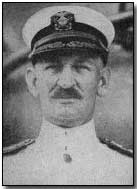Who's Who - Henry Thomas Mayo
 Henry Thomas Mayo (1856-1937) commanded
the U.S. Atlantic Fleet from June 1916 and continued to hold the position
following
America's entry into World War One in April 1917.
Henry Thomas Mayo (1856-1937) commanded
the U.S. Atlantic Fleet from June 1916 and continued to hold the position
following
America's entry into World War One in April 1917.
Having graduated from the U.S. Naval Academy in 1876 Mayo subsequently served during the 1883 Greely relief expedition to the Arctic. He acted as navigator of the hydrographic vessel Bennington from 1895-98, during which time he helped survey Pearl Harbor.
Promoted to command of divisions of the Atlantic Fleet in 1913 Mayo was instrumental in requesting and requiring from Mexico a formal public apology for the actions of Mexican authorities in seizing an unarmed U.S. party of sailors while ashore at Tampico on 9 April 1914 (the so-called Tampico Incident).
Mexico's refusal to accede to the U.S. demand for an apology led to President Wilson's instruction to seize the Mexican customs house at Vera Cruz. This in turn led to the fall from power of the Mexican dictator General Victoriano Huerta.
In 1916 Mayo was handed full command of the Atlantic Fleet and promoted Vice-Admiral, a post he held throughout his country's involvement in World War One. He travelled to London in August 1917 to discuss Allied naval co-operation, and was an advocate of a convoy anti-submarine policy as well as the construction of the Northern Barrage anti U-boat minefield.
Following the war Mayo served as chairman of the U.S. Navy's General Board, arguing in favour of smaller warship construction, until his retirement in 1920. He was subsequently promoted full Admiral on the retired list in 1930.
He died in 1937.
One in five of the Australians and New Zealanders who left their country to fight in the war never returned; 80,000 in total.
- Did you know?
